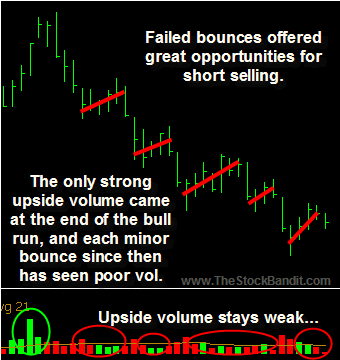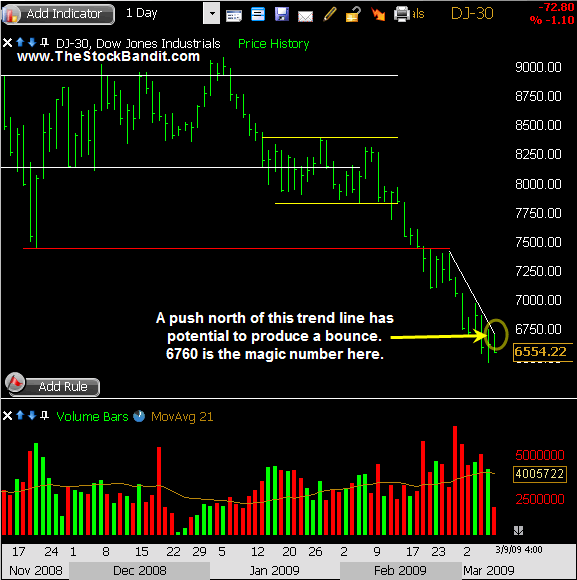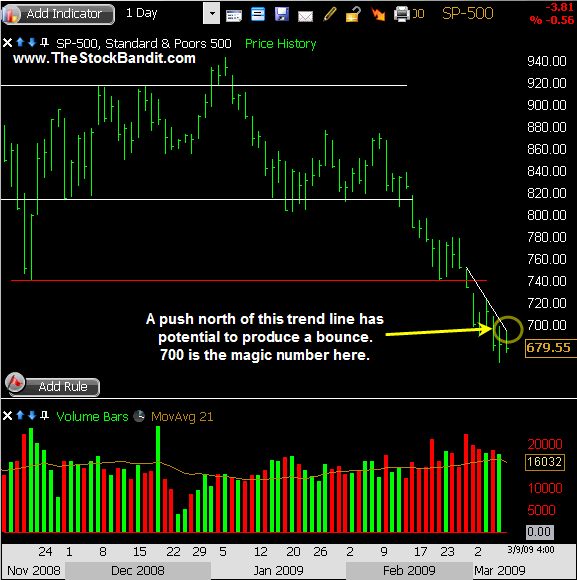 All Entries in the "Chart Reviews" Category
All Entries in the "Chart Reviews" Category
Steep Trend Lines Beg to Be Crossed
March 9, 2009 at 12:41 pm
This market is ugly – as in really hideous.
Fear & Panic aren’t really even the appropriate words at the moment for this price action. It’s more like sheer disgust.
Would-be buyers are trusting that they’ll see lower prices (almost by the day) to put their cash to work, so what’s the hurry? And at the same time, bears who will eventually cover aren’t having to tiptoe around – they’re strutting. Likewise, they sense no urgency for needing to exit short sales.
Such is the nature of a downtrend.
From the Mood to the Technicals
But as is often the case, there is a technical threat of a short-term reversal. And it isn’t based on the oversold indications which are quite prevalent right now. Simple is usually better in technical analysis, so in this post I’m just going to point to a couple of trend lines which are looking a bit too steep.
It’s important to note that the steeper a trend line tends to be, the more likely (and the sharper) a short-term reversal becomes. So this is no prediction, but watch for a cross of these trend lines in the coming days should it happen to occur. If it does, it just might produce a playable bounce. (Notice I said bounce.)
A Look at the Charts
Up first: the DJIA. Keep in mind this trend line is descending daily, so it changes daily. At the moment though, a push back above the 6760 area would clear it. Have a look:
StockFinder Chart courtesy of Worden
Next: the S&P 500. Here again, the trend line descends daily and therefore should be double-checked to determine its exact value. For now, a push back above the 700 level would produce an upside break and might result in a tradable bounce. Here’s the chart:
StockFinder Chart courtesy of Worden
I hope your trading week is a good one!
Jeff White
President, The Stock Bandit, Inc.
Swing Trading & Day Trading Service
www.TheStockBandit.com
[tags]Stock Market, Day Trading, Stock Trading, Investing, Swing Trading[/tags]
Know Your Method
January 20, 2009 at 11:29 am
For nearly a year and a half, I’ve been blessed to be a dad. It’s been an awesome experience, and I have really learned a lot (though I still have a long way to go).
During the same time, I’ve been able to observe my wife in her role as a mother, and it’s really amazing how quickly a mother knows what their child needs! I had heard of a mother’s intuition, but witnessing it first hand really puts it into perspective.
I think mothers start out with an innate ability, a talent, to determine their child’s needs. And yet there are still the elements of practice and experience which enhance the natural talent that was there to begin with. It takes work, but the combination of talent and effort produces quite a skill.
Similarities Abound
Trading isn’t any different in that regard.
As traders, each of us start out with some kind of talent. It may be that we take quickly to reading the tape and gauging momentum, or it might be that we realize very quickly just where the boundaries of our comfort zones are when it comes to risk tolerance. Whatever it happens to be, generally it isn’t long before we start to build a method around our needs.
And what’s so nice about trading is that’s entirely possible in the market – since there are so many ways to seek out profits. We truly can custom-build a method which is fully-suited to us.
Once we get to that point, and if we want to trade responsibly, then one of our biggest obligations is to understand our method backwards and forwards. We don’t have to know everything about the market or be able to predict what’s going to happen next. Anyone who tells you otherwise just hasn’t traded much. All we need to do is keep our eye on the ball and continue to monitor and adjust the way we’re trading in order to achieve better results.
Worthwhile Effort

Just like a mother’s watchful eye on her child, our ongoing effort to remain aware of everything that’s taking place can lead to a great understanding of our method. As a result, we quickly learn when to adjust and how to go about modifying our approach whenever necessary.
What would it mean to you if you understood your method well enough that you could make small adjustments on the fly and right away improve your results? It would be huge, wouldn’t it?
As the newness of the year begins to fade and early resolutions fall by the wayside, take a stand for your trading. Make a commitment – a goal – right now to become sharp enough that you pick up on subtle changes in the trading landscape which warrant your attention.
Learn to detect when the environment is not ideal for your trading, so that you will know when to adapt or back down. And then when you see opportunities to do so, make those small adjustments so that you can stay on top rather than falling behind.
Jeff White
President, The Stock Bandit, Inc.
Swing Trading & Day Trading Service
www.TheStockBandit.com
[tags]Stock Market, Day Trading, Stock Trading, Investing, Swing Trading[/tags]
Market View Video September 1, 2008
September 1, 2008 at 12:18 pm
Now that Labor Day is going to be behind us, the moment of truth arrives for this market. Specifically, can volume finally perk back up to respectable levels?
We’re probably going to need it if we want to get out of these trading ranges in the major indexes, but historically we do see volume begin to pick back up post-Labor Day, so the odds are in our favor.
Before you get active this week, be sure to check out this week’s Market View video over at the main site for a closer look at the averages and some things to consider if you’re trading.

(Click image to view video)
Trade well this week!
Jeff White
President, The Stock Bandit, Inc.
Swing Trading & Day Trading Service
www.TheStockBandit.com
[tags]Stock Market, Day Trading, Stock Trading, Investing, Swing Trading[/tags]
Identify Failing Bounces for Short Selling
August 20, 2008 at 7:45 am
Traditional Wall Street tells you that the market goes up over time, which has proven to be true. That’s nice if you’re a “long-term investor” who socks money away in mutual funds and doesn’t care about working your capital a little harder.
But for the self-directed trader, it’s important to remember a couple of things. First, the market (and stocks and sectors) will undergo corrections from time to time. Even if a longer-term trend persists, short-term hiccups and even the occasional gasp for air will occur. Second, those corrective phases (or downtrends) offer the best opportunities for short selling if you know what you’re doing.
Flip the Chart if You’re a Bull
You might be predisposed to trading the long side, in which case you’ll certainly relate to this analogy. Within uptrends, buying dips can be an excellent strategy to participate in the move. Doing so allows you to effectively buy on a short-term discount a stock which is in the midst of a longer-term advance. On the flip side, one of the best ways to participate in a profitable way within downtrends is to correctly identify failing bounces.
It’s the mirror-image of buying dips.
Shorting failing bounces can be a great way to trade the dark side, but it does require some finesse and an added dose of patience. These aren’t like breakout plays where you should expect an almost immediate pop and follow through. Rather, they are sometimes more like watching a cruise ship turn around… it might take a couple of days before the direction really changes! With that being the case, these kinds of plays are usually best for swing trading.
The Look
So with the concept laid out before you, let’s talk about what to look for and then I’ll show you an example. What we want to find is a stock which is in fact trending lower. That means lower highs and lower lows are in place, so that support levels have been broken in recent weeks or days with some high-volume selling. Since then, the stock has attempted to bounce back up but has been unable to attain previous relative highs on the chart.
Furthermore, as price goes up in the near term, volume is going down. That creates a negative divergence which shows us that the move is more of a dead-cat bounce as opposed to true accumulation taking place. Often times this establishes a bear flag or rising wedge pattern. As these patterns are confirmed, you’ve got a trade candidate on your hands.
Here’s what good shortable failed bounces look like on the chart, and be sure to notice the lack of solid volume on each bounce attempt:

Chart Courtesy of Blocks
As you find these types of setups, be sure to take notice of the duration of each bounce since stocks will often stick with a certain rhythm in how they move. Also seek to find some sympathy weakness occurring either in the same sector or in the overall market. That way when the time is right, you’ll be putting the odds of success in your favor as you profit from the next decline rather than just endure it.
Trade well out there!
Jeff White
President, The Stock Bandit, Inc.
Swing Trading & Day Trading Service
www.TheStockBandit.com
Trading Video – 3-26-2008
March 26, 2008 at 2:52 pm
I thought I’d mix things up a little bit and post a video of a trading lesson I learned in the market today.
If we’re open-minded and attentive, the market is always showing us ways to improve our trading results. Today’s video shows you a trade we just closed out today for a nice gain over at TheStockBandit.com, and I hope you find it useful!
Feel free to share it if you’re a fellow blogger, the embed code is on the YouTube page.
Without further delay, here’s the clip:
Jeff White
President, The Stock Bandit, Inc.
Swing Trading & Day Trading Service
www.TheStockBandit.com
[tags]Stock Market, Day Trading, Stock Trading, Swing Trading, Trading Video, Investing[/tags]
Take Cues From Failed Patterns
December 18, 2007 at 6:35 am
Chart patterns are great for selecting trade entries, but rarely do I see them being discussed from the perspective of risk management. One of the best things about them in my opinion is that they show me clearly when I should be in or out of a trade. When they fail, the signals are clear and I can limit my loss. What else could I possibly want when I’m wrong??
Take SOLF for example. This stock recently tripled in just a few short weeks, putting it on the radar of every momentum trader around. With ample liquidity and lots of strength, it’s no wonder it hit my watch list. I particularly liked the symmetrical triangle pattern it formed as it consolidated recent gains, creating a nice pivot point for an entry on the long side.
I bought it on Friday morning for a trade as it cleared $27.25 at the upper trend line of the triangle, but the stock couldn’t hold the breakout and failed soon afterward. I took a loss of 2% on the failed trade (I’ve certainly had worse). Although a losing trade isn’t any fun, I definitely felt the setup deserved a chance, and if faced with the same opportunity again I’d take it. However, I limited my loss because the pattern failed.
The stock is now 10% below my exit price just one session later. Taking my cue from a failed pattern really prevented additional pain, allowing me to move on to the next trade and protect my capital rather than babysit a stock which had reversed and hope for a comeback.
Here’s a look at SOLF and the failed symmetrical triangle pattern:

(Click for full-size image, courtesy of TeleChart)
Trade great setups which offer big potential rewards when you see them, but be sure to let the patterns you’re trading guide your exits as well.
Jeff White
President, The Stock Bandit, Inc.
Swing Trading & Day Trading Service
www.TheStockBandit.com
[tags]Stock Market, Day Trading, Stock Trading, Investing, Swing Trading[/tags]
When Character Changes
October 23, 2007 at 7:34 am
Anytime we see a big contra-trend move like we got last Friday, the discussions begin….
Was it the end of the trend? Is this just another dip to be bought? Is the world ending?
Those questions arise for the overall market, but also for individual stocks. In reference to the stocks, the answer to all 3 questions is yes, depending of course on the stock in question.
Whenever I am considering whether a dip is buyable, the most important aspect of the stock to evaluate is whether the character has completely changed or not. Some stocks go through a minor character change when they see a minor dip in the midst of a strong uptrend, but others will reverse course sharply and never look back. The latter kind is what I want to avoid like the plague!
As you begin to work your watch list and seek out potential long-sided plays in the days ahead, take careful note of just how intense the dips are. Doing so will greatly assist you in deciding whether a buy is warranted, or if instead you need to keep waiting for a better opportunity.
Let’s look at a couple of examples.
MMM was trending nicely higher recently, climbing and basing on the way up in a healthy fashion. This stock’s ability to put in rest helped it keep climbing without getting too extended. A couple of weeks ago, MMM began to pull back gradually, but the uptrend was still intact. This stock actually had found support just above an old base, but then came Friday’s sharp move lower on heavy volume. The big spike down was followed by more weakness on Monday, and needless to say this chart no longer resembles an uptrend. As a result, I’ll avoid buying anything that looks like this.

(Click for full-size image, courtesy of TeleChart)
NUAN has been trending higher the past few months, and this stock also recently began a pullback. It also took a dip on Friday (and Monday temporarily), but the character of the stock was not affected. The pace of the pullback has remained constant, as is evident by the trend line just overhead. This is the kind of setup which I would consider putting on watch for a potential long-sided play once things shape up (and if it could clear the trend line). Stocks which may be impacted by widespread selling pressure but which still hold up relatively well are the only stocks worth looking at once the storm passes.

(Click for full-size image, courtesy of TeleChart)
Be careful out there with new buys, and pay close attention to the character of your stocks! If the intensity of their pullbacks worsen considerably, cross them off your list of buy candidates and move on to the next good setup.
Jeff White
President, The Stock Bandit, Inc.
Swing Trading & Day Trading Service
www.TheStockBandit.com
[tags]Stock Market, Day Trading, Stock Trading, Investing, Swing Trading[/tags]







